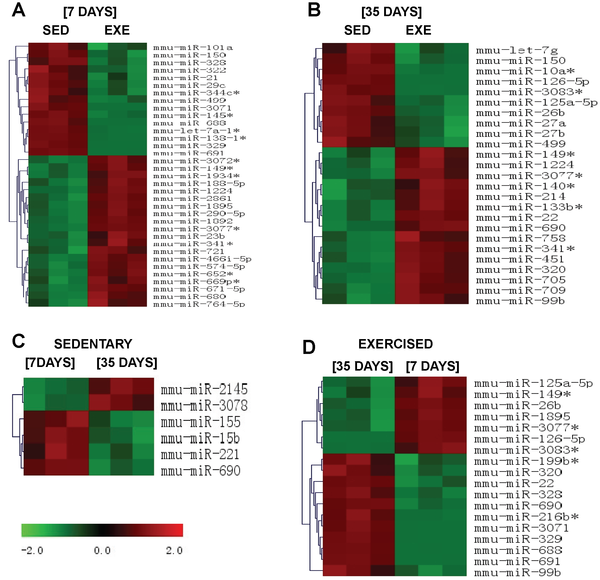MicroRNAs (miRs) are a class of small non-coding RNAs that regulate gene expression. Studies of transgenic mouse models have indicated that deregulation of a single miR can induce pathological cardiac hypertrophy and cardiac failure. The roles of miRs in the genesis of physiological left ventricular hypertrophy (LVH), however, are not well understood. That’s why miR expression and left ventricular hypertrophy was the focus of a recent paper published by researchers from Hospital de Clínicas de Porto Alegre. To evaluate the global miR expression in an experimental model of exercise-induced LVH, researchers divided male Balb/c mice into sedentary (SED) and exercise (EXE) groups. Voluntary exercise was performed on an odometer-monitored metal wheels for 35 days. Various tests were performed after 7 and 35 days of training, including a transthoracic echocardiography, a maximal exercise test, miRNA microarray service(miRBase v.16) provided by LC Sciences and qRT-PCR analysis. The ratio between the left ventricular weight and body weight was increased by 7% in the EXE group at day 7 (p<0.01) and by 11% at day 35 of training (p<0.001). After 7 days of training, the microarray identified 35 miRs that were differentially expressed between the two groups: 20 were up-regulated and 15 were down-regulated in the EXE group compared with the SED group (p = 0.01). At day 35 of training, 25 miRs were differentially expressed: 15 were up-regulated and 10 were decreased in the EXE animals compared with the SED animals (p<0.01). The qRT-PCR analysis demonstrated an increase in miR-150 levels after 35 days and a decrease in miR-26b, miR-27a and miR-143 after 7 days of voluntary exercise. Their work has identified new miRs that can modulate physiological cardiac hypertrophy, particularly miR-26b, -150, -27a and -143. Their data also indicate that previously established regulatory gene pathways involved in pathological LVH are not changed in physiological LVH.
The green boxes represent down-regulated miRs, and the red boxes represent up-regulated miRs, compared with controls. (A): Comparison of sedentary (left 3 columns) and exercised (right 3 columns) animals at day 7. (B): Comparison of sedentary (left 3 columns) and exercised (right 3 columns) animals at day 35. (C) Comparison of sedentary animals at days 7 (left 3 columns) and 35 (right 3 columns). (D) Comparison of exercised animals at days 7 (left 3 columns) and 35 (right 3 columns). All comparisons have p values <0.01.
Related Service
miRNA Microarray Service – LC Sciences provides a microRNA (miRNA) expression profiling service using microarrays based on our in-house developed µParaflo® technology platform. We have standard arrays for all mature miRNAs of all species available in the latest version of the miRBase database (Release 21, July 2014). Our service is comprehensive and includes sample labeling, array hybridization, image data processing and in-depth data analysis. Two-three weeks after receiving your total RNA samples, we’ll send you both the raw and fully analyzed data. [Learn more…]
Reference
Martinelli NC, Cohen CR, Santos KG, Castro MA, Biolo A. An Analysis of the Global Expression of MicroRNAs in an Experimental Model of Physiological Left Ventricular Hypertrophy (2014) PLoS ONE 9(4): e93271. [article]

